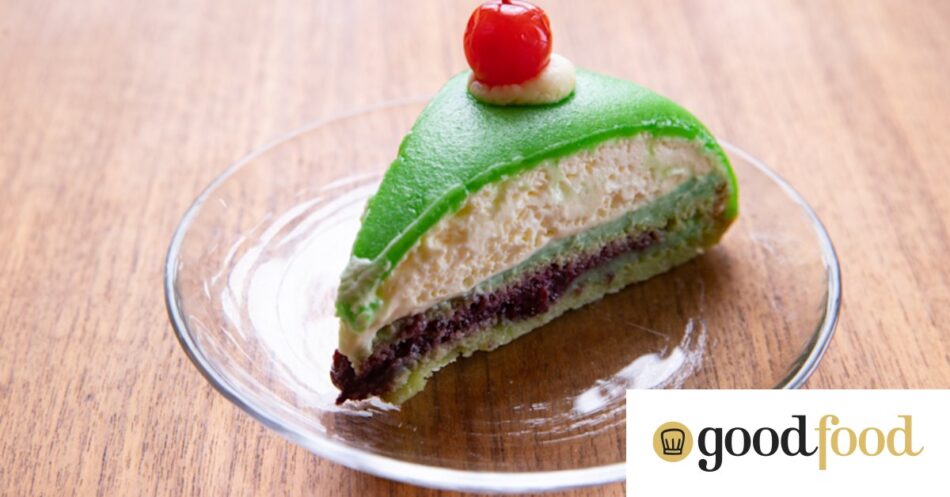Restaurants and bakers have been leaning heavily into nostalgia over the past few years, and one of the more recent hits is the marzipan-covered “prinsesstarta”.

Maybe it’s the cyclical nature of food trends, or the comfort of childhood memories in uncertain times, but whatever the reason, there’s been a steady rise in nostalgic dishes. From a resurgence of retro diners to dishes such as devilled eggs and chocolate mousse, more bakers and chefs are leaning into sentimentality.
One particularly retro dessert popping up at cafes and bakeries is on the precipice of taking the world by storm (again). Welcome, the Swedish princess cake – better known in its homeland as the prinsesstarta.
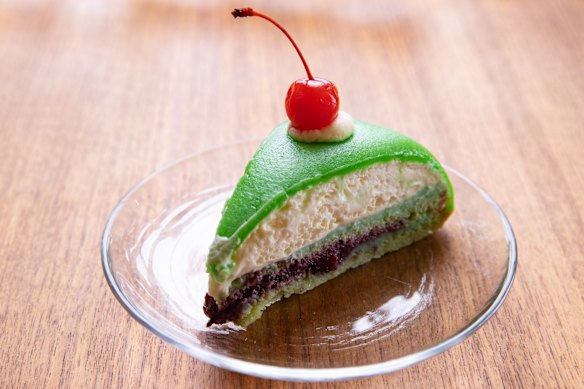
Fans of The Great British Bake Off may recall Mary Berry’s version of the dessert featured in an episode aired more than a decade ago. The torte encompasses fluffy sponge cake flanked by custard and jam, coated in whipped cream and encased in a thin layer of rolled marzipan or mandelmassa (almond paste). It’s traditionally dyed green and topped with a single marzipan pink rose.
Baker Raymond Tan, of popular Melbourne CBD bakeshop Raya, recently opened “Scandinasian” bakery Dua Bakehouse and thrust the prinsesstarta back into the zeitgeist. Inspired by Tan’s time spent in Stockholm and his upbringing in Malaysia, Dua’s take on the dessert infuses the marzipan with pandan essence as a substitute for green food colouring, giving it both colour, fragrance and a South-East Asian spin. “From there, everything else followed,” says Tan.
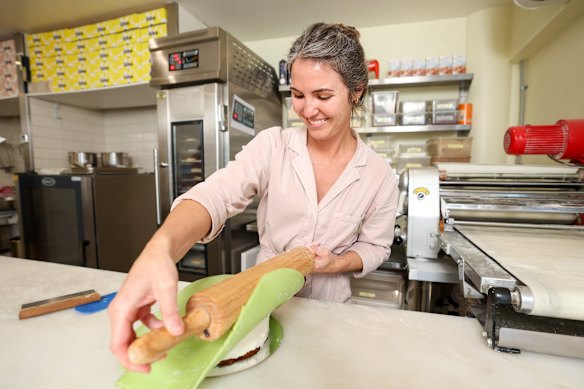
“There’s pandan chiffon for the sponge, which we’ve been making for years at Raya, and a pandan custard cream that’s a gentle nod to pandan kaya. We also use a boysenberry jam, which we know works with whipped cream, a little ode to the cinema choc-top.” (Clock up another nod to nostalgia.)
Meanwhile, princess cake is one of the star desserts at Fika the Bakery in Manly, Sydney, named after the Swedish tradition of taking a break for coffee and cake.
Here, the prinsesstarta is as traditional as it gets – a light, fluffy sponge sandwiched between raspberry jam and balanced by sweet and tangy custard, plus “just the right amount of cream and top-quality marzipan”. These are the hallmarks of a good princess cake, says Fika co-founder Sophie Curl.
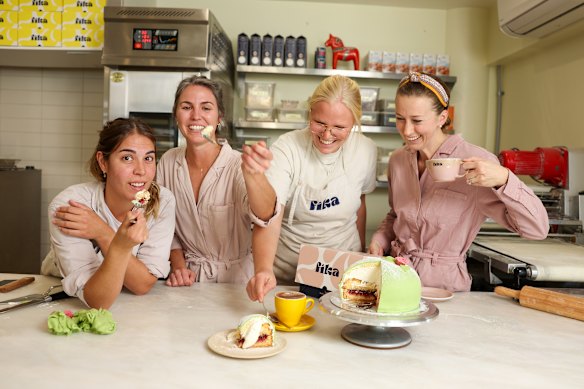
“If you can resist finishing it all at once, save a slice for the next day,” Curl notes. “The flavours only get better.”
The Manly bakeshop owner says she has observed a noticeable uptick in princess cake sales over the past year or two. “They’ve become so popular that we’ve started creating playful twists – like a heart-shaped pink princess cake for Valentine’s Day, and an Easter version with coconut, mango and passionfruit wrapped in a marbled yellow and pink marzipan instead of the classic green.”
Food historian and associate lecturer at the University of Wollongong Dr Lauren Samuelsson says the popularity of green cakes is punctuated throughout history. Monet’s favourite cake was said to be a “le gateaux vert” (green cake) coloured with spinach and pistachios in a time long before food dye.
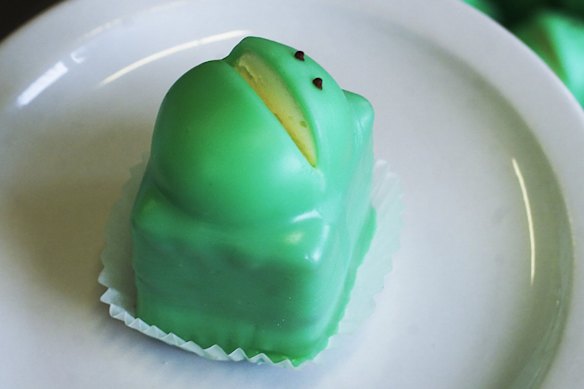
“Green is kind of the colour of the decade, too, with matcha and pistachio really having a moment and ‘Millennial green’ trending,” says Samuelsson. In parallel with the princess cake’s rise, vivid green versions of its Sicilian cousin – the cassata – have also been appearing on more bakery shelves and dessert menus.
Samuelsson theorises that the domestic appeal of the princess cake – and green cakes in general – may also stem from Australians’ fondness for the “frog cake” made by Adelaide-based Balfours since the 1920s. These cakes are also sponge-based and layered with jam and cream, but covered in green fondant as opposed to marzipan (not to mention being shaped like a frog’s head).
Tan concurs, likening food to fashion in terms of its waxing and waning trend cycles. “For the princess cake, I think there’s the visual nostalgia of the dome and the familiarity of green-hued desserts,” he says.
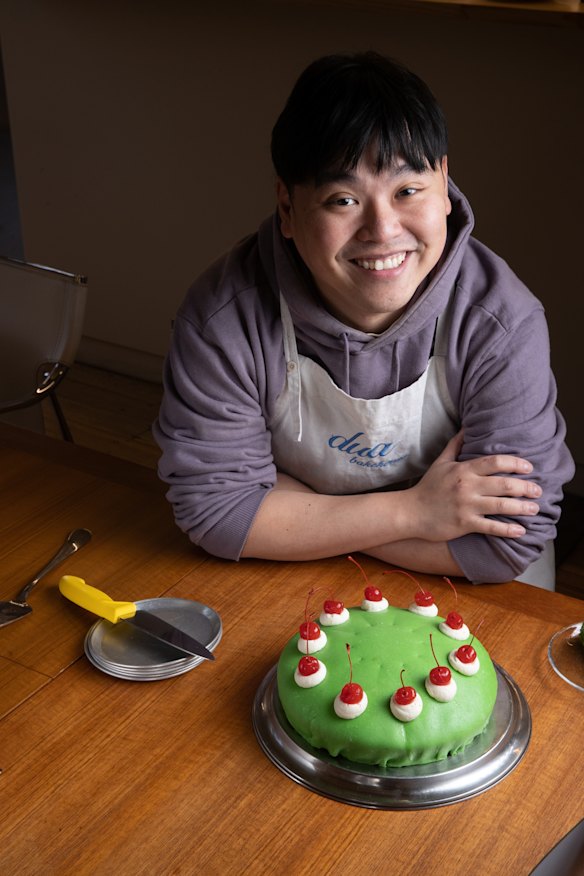
“When I started my first bakery, I drew heavily on the sweets I grew up with in Malaysia – things flavoured with pandan, matcha, coconut and ube. Now those ingredients are becoming more mainstream, but to me, they’ve always been home … I’m glad it’s become a novelty.”
The princess cake is actually relatively new as far as food history goes – it was only popularised in Australia around the 1960s and ’70s amid a Scandi food fad (read: Swedish meatballs and fondue).
But its origin story doesn’t date back too much further. The first recipe for prinsesstarta appeared in a 1948 cookbook by Swedish home economist Jenny Akerstrom.
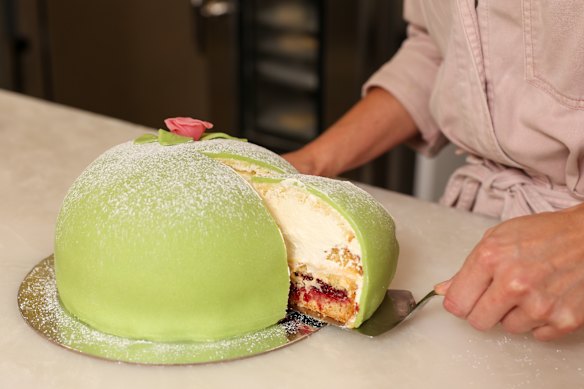
“She had a bit of clout in the Swedish culinary realm,” says Samuelsson. “Not only was she a tutor to Prince Carl of Sweden’s three daughters – the princesses after whom the cake was named – she had released an earlier cookbook called The New Cookbook of the Princesses in the 1930s.”
Originally, the recipe was published as “gron tarta” (green cake) thanks to its signature green marzipan shell, though later took a more appetising rebrand. Tan recalls that when he first tried prinsesstarta in Stockholm before opening Raya, he was enamoured by its appearance, textures and layers.
“It sometimes pops up in the Ikea food hall and I always grab one,” he says. “I’ve quietly dreamed of doing a version ever since, and this felt like the right time to put it on the menu when I was setting up Dua.”
Where to find a prinsesstarta or cassata
Melbourne
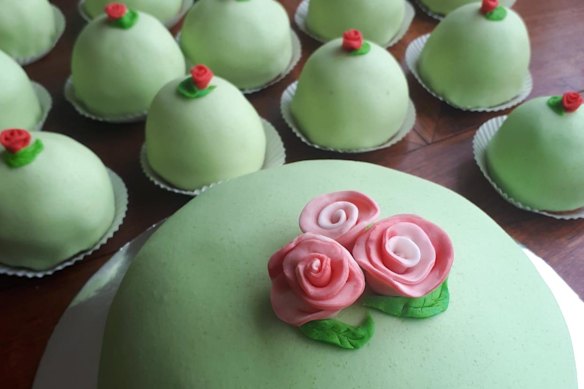
Inner West Swedish Baker
A traditional prinsesstarta goes for $120 for a full-sized cake, or you can grab mini versions for $10 each. The bakery makes all the cake’s components from scratch, and does custom colours for special events.
549A Barkly Street, West Footscray, innerwestswedishbaker.com.au
Dua Bakehouse
Dua’s pandan princess cake has taken Melbourne by storm – and put a whole new spin on the traditional prinsesstarta. Pop into the Collingwood Yards bakery to get a slice of the green-hued dessert for $12.
1/35 Johnston Street, Collingwood, instagram.com/duabakehouse

Brunetti Oro
Melbourne icon Brunetti’s Oro offshoot – found in Brunswick and at multiple CBD outposts – sells a whole cassata for $55.90. It’s made with sweet ricotta, chocolate chips and liqueur-laced vanilla sponge, all encased in green marzipan.
Multiple locations, brunettioro.com.au
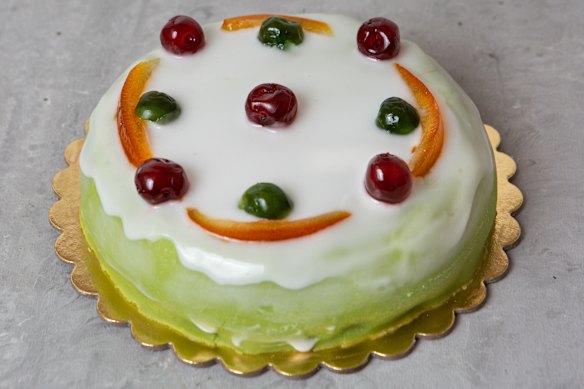
Pulcinella
Brunswick bakery Pulcinella’s cassata Siciliana is $48 for a full-sized cake, or $8 for a single-serve version reminiscent of the breast-shaped Cassatella di sant’Agata. It features fluffy vanilla sponge filled with ricotta, and covered with pistachio marzipan and sugar fondant.
592 Sydney Road, Brunswick, pulcinellacaffe.com.au
Sydney
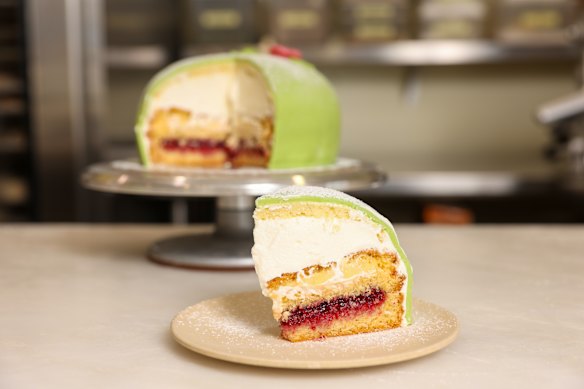
Fika
Sydney’s most traditional princess cake is available at Fika’s original Manly cafe, plus its newer bakery for $110. It can also be made with pink marzipan, or in smaller sizes.
5B Market Lane, Manly and 5A Raglan Street, Manly, fika.au
Da Orazio Pasticceria
It’s not quite a princess cake, nor a cassata, but Alexandria’s Italian pastry shop Da Orazio offers a similarly green cream sponge cake layered with pistachio mousse and passion fruit curd, and finished with a “green mirror glaze”. The pistachio and passionfruit cake costs between $50 and $90 depending on size.
200 Euston Road, Alexandria, daoraziopasticceria.store
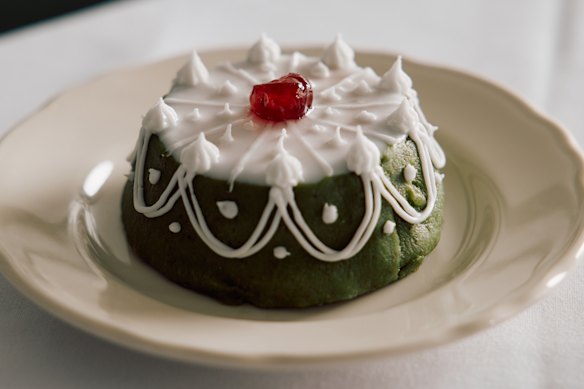
Osteria Mucca
Recently hatted Italian restaurant Osteria Mucca in Newtown serves pastry chef Lauren Eldridge’s version of the Sicilian cassata. A shell of pistachio marzipan and candied fruits conceals a Strega liqueur-soaked sponge and chocolate ricotta, all finished with intricate fondant lacework. It’s on the dessert menu for $28.
212 Australia Street, Newtown, instagram.com/osteriamucca
Brisbane
Bake My Day
Brisbane-based Swedish pastry chef Maria Lindholm makes custom cakes, pastries and more from her business Bake My Day – including traditional prinsesstarta. The Swedish cake goes for $60 and can be baked in an array of shapes, sizes and colours.
Home bakery, facebook.com/bakemydaybrisbane
Gerbino’s
Italian bakery Gerbino’s offers a traditional Sicilian cassata Sicilian for $55, in addition to a second version with fresh cream on top rather than fondant – “for the not so sweet tooths”. Owner Salvatore also makes individual cassatella di Sant’Agata by request for $6 each.
166 Ashgrove Avenue, Ashgrove, gerbinos.com.au
Perth
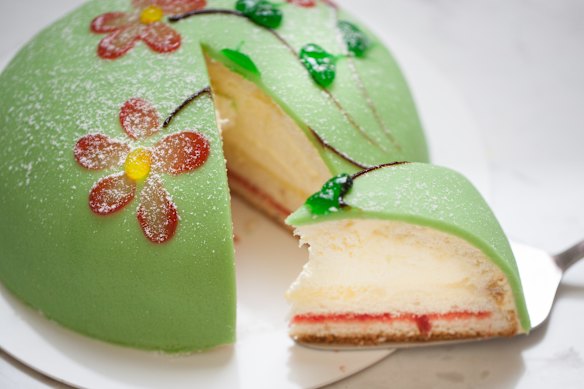
Miss Maud
Miss Maud arguably kick-started the prinsesstarta craze Down Under when it opened over 50 years ago. Founder and managing director Maud Edmiston migrated to Perth from Sweden in the late ’60s. Realising how much she missed Stockholm cafes, Edmiston opened up the first Miss Maud Swedish Pastry House in 1971 at the former Carillon City shopping centre. To this day, the Perth bakery is known for its signature Swedish cake, available across its 15 outlets for $41.60 or $8.10 per slice.
Multiple locations, missmaud.com.au
Make-at-home
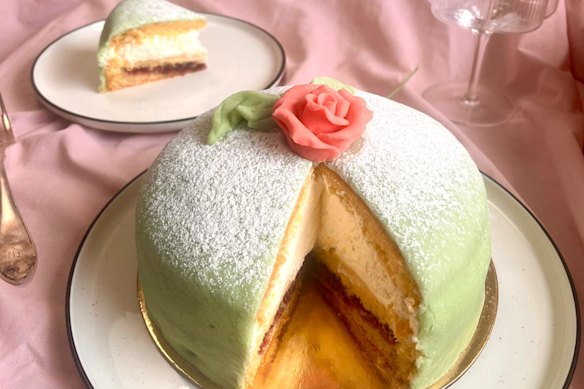
Nordic Bake Box
Still can’t find a princess cake near you? Nordic Bake Box is an online shop offering kits to recreate traditional Nordic sweets at home – including, of course, prinsesstarta. The $44.90 princess cake kit includes all the pre-measured ingredients needed to make a soft vanilla sponge, cream filling, and marzipan icing, plus a gold cake tray, piping bag and detailed recipe card with access to an online tutorial. All you need to purchase additionally is fridge essentials: butter, eggs, milk and raspberries, plus green food colouring.
Restaurant reviews, news and the hottest openings served to your inbox.

